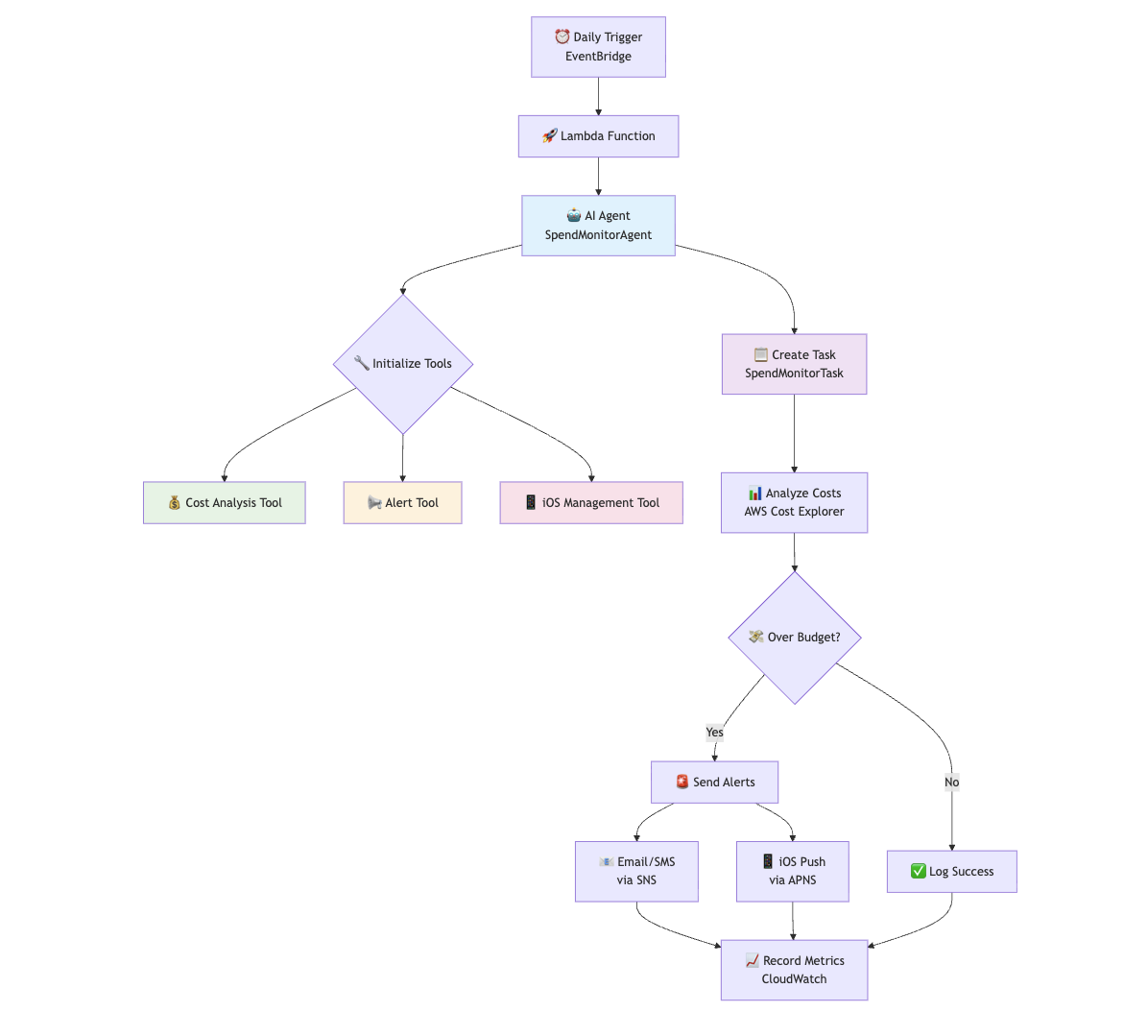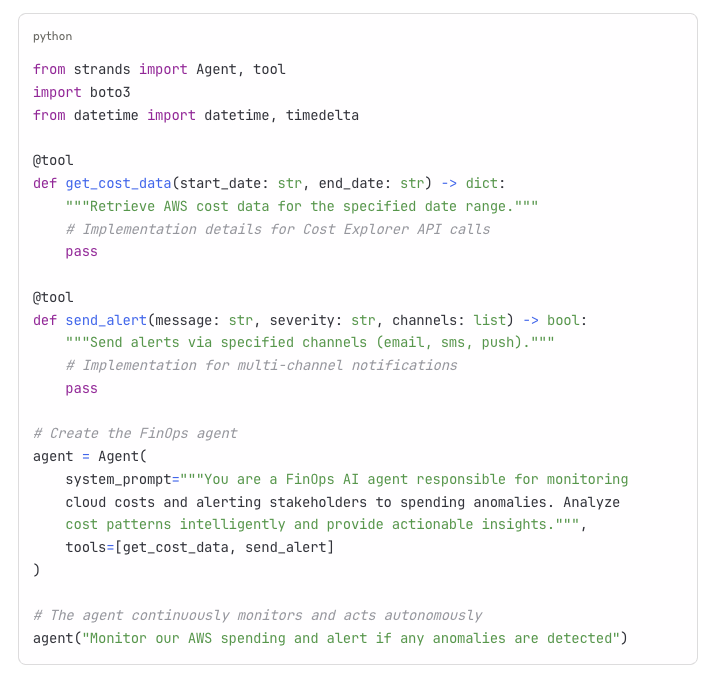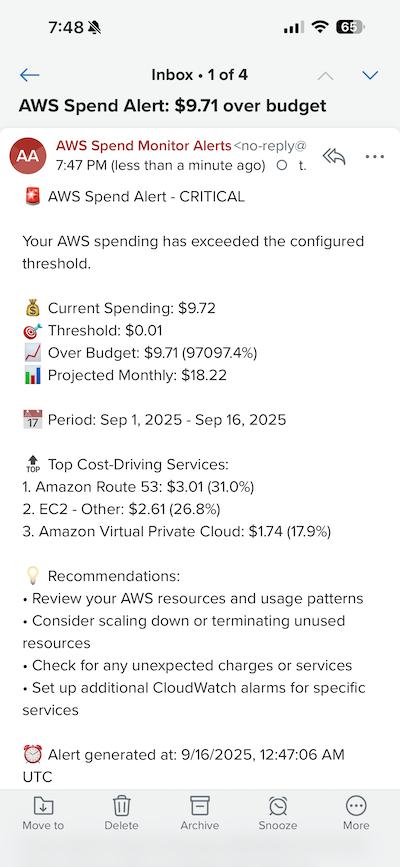From AI to Agents: Building Smarter Systems that think, decide and act
Exploring the evolution from AI to AI Agents with a hands-on FinOps example. Learn how AWS Strands enables autonomous agents to monitor cloud spend, notify on overages, and free humans to focus on higher-judgment work.
From AI to Agents: making software that thinks, decides, and acts!
We’re witnessing a fundamental shift in how we interact with artificial intelligence. While traditional AI systems excel at answering questions and generating content, they operate in isolation: responding to prompts but unable to take action in the real world. Enter AI agents: the next evolution that bridges this gap between intelligence and action.
AI agents are autonomous software systems that use artificial intelligence, such as the frontier large language models (LLMs), to perceive their environment, make decisions, and take actions to achieve user-defined goals with minimal human intervention. Unlike static AI models that respond to queries, agents actively monitor, reason, and act upon their surroundings, creating a dynamic feedback loop that enables truly intelligent automation.
This evolution represents a paradigm shift from reactive to proactive AI. Instead of waiting for human input, AI agents continuously observe their environment, identify opportunities or issues, and autonomously execute appropriate responses. They combine the reasoning capabilities of modern LLMs with the ability to interact with external systems, APIs, and services, creating intelligent systems that can manage complex workflows end-to-end.
What I’m building
In my quest to learn by doing, I decided to work on a personal project that yielded tangible results, helping me understand the value of AI Agents. My day job is all about maximizing the value of our cloud investments. As part of my learning journey, I am building a simple, real-world agent that watches my personal Cloud spend and notifies me when I’m trending over budget. The agent sends alerts via email, text, and iOS push notifications, so I actually see them. The point is not novelty, it is leverage. If an autonomous system can handle routine FinOps hygiene, humans can spend more time on architecture, savings plans, and strategy.
This example uses the Strands Agents framework from AWS to perform the heavy lifting and simplify the development of AI agents. Here is a simple flowchart that demonstrates how this simple AI Agent works.

Introducing the AWS Strands Framework
Strands takes a model-driven approach to building and running AI agents, enabling them to be created and deployed in just a few lines of code. This approach scales from simple to complex agent use cases, as well as from local development to production deployment.
What makes Strands unique is its philosophy of letting the LLM serve as the orchestrator. Rather than requiring developers to define complex workflows for their agents, Strands simplifies agent development by embracing the capabilities of state-of-the-art models to plan, chain thoughts, call tools, and reflect. This approach allows developers to focus on defining the agent’s purpose and available tools, while the framework handles the complex orchestration logic. The simplified code snippet in the image below showcases the elegance of the Strands framework.

Try it yourself
The project I've created is open source. Please download and try it out yourself. You can read the overview and setup notes here:
- GitHub Project where this project lives
- Project README with goals and usage instructions
- FinOps-AIAgent details with behavior and alert notes
- Strands Agents documentation for concepts, quickstart, and deployment options
See the Agent in Action
One of the most satisfying moments in building this AI Agent was seeing it spring into action. Instead of quietly running in the background, it actively watched my AWS account and sent me an alert the moment my spend crossed the budget threshold. It felt like having a diligent teammate who never sleeps, always on the lookout. Here’s the actual email it generated — proof that the agent is not just an idea, but working in practice.

The Future: From Toil to Judgment
The real promise of AI agents isn’t in saving a few keystrokes or sending one more alert. It’s in transforming how we work. Much of the energy in today’s enterprises is still consumed by toil—manual checks, repetitive approvals, constant monitoring. That work is essential, but it rarely calls on our best selves. It doesn’t demand deep judgment, creativity, or empathy. It just has to get done.
Agents are a lever against that gravity. They will automate the baseline work that keeps systems running and budgets under control. In doing so, they create space for people to focus on what only people can do—making complex tradeoffs, exercising judgment in ambiguous situations, and shaping a strategy that balances innovation with responsibility. In the same way cloud freed us from racking servers and patching disks, AI agents will free us from babysitting dashboards and chasing cost anomalies.
My thesis is simple: the future of work will be defined by how effectively we use agents to reduce toil and reclaim human judgment. As agents become more capable, our value won’t be measured by how fast we can click through tasks, but by how thoughtfully we apply insight, creativity, and leadership to the decisions that matter. In a sense, AI isn’t replacing us—it’s reminding us what we’re actually here for.
Share this post
Related Posts
Frontier Models, Small Language Models, and a New Middle Path
🤖 Frontier Models, Small Language Models, and a New Middle Path The most strategic AI decision isn't choosing the right model — it's knowing when generic intelligence isn't enough. Over the past...
My Journey to Trusting GenAI With More of My Code
How my workflow evolved from autocomplete magic to spec driven development, and why trusting GenAI with more of my code has changed how I build software.
The Rise of MCP Servers: Why Every Developer Will Have a Personal AI Toolchain
From AWS to GitHub to Podman, MCP servers are quietly becoming the new plug-in ecosystem for developers—and it’s changing how we work.